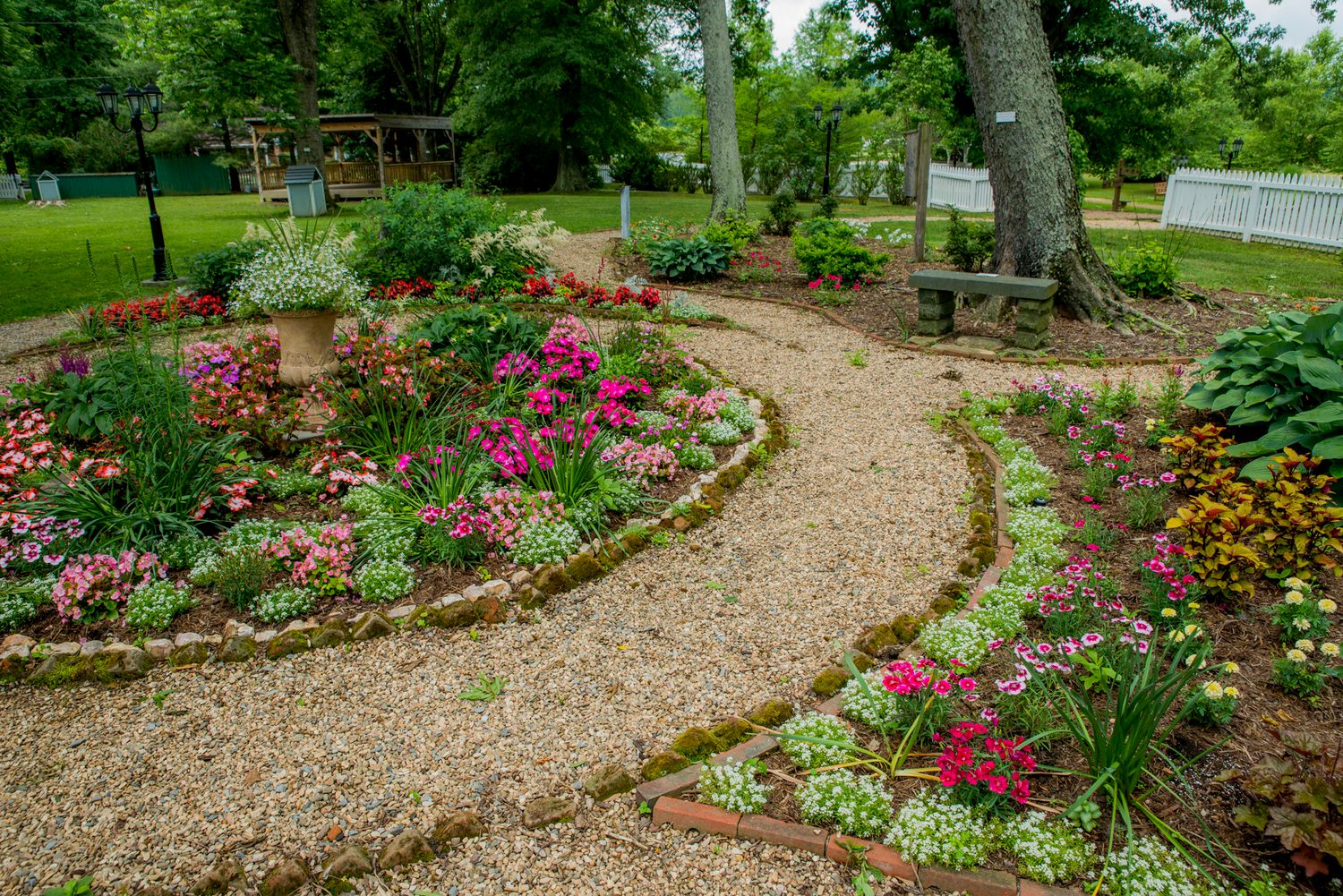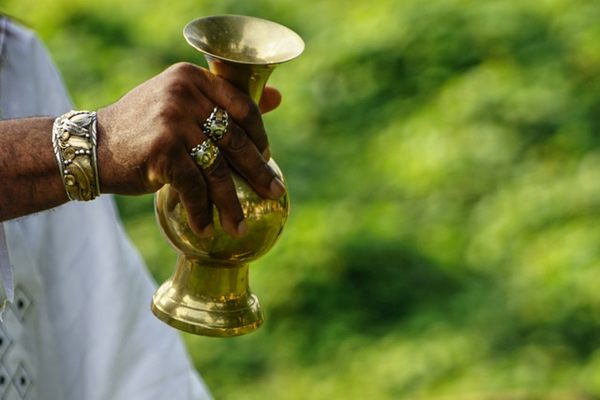The Hidden History of African-American Burial Sites in the Antebellum South
Enslaved people used codes to mark graves on plantation grounds.

In modern-day Altavista, Virginia, a town that covers 5 square miles of what was the first English colony in North America, sits the Avoca Museum. The land was settled in 1755 by Colonel Charles Lynch, a politician and American Revolutionary Patriot, while the current structure was built in 1901 and is now a Virginia Historic Landmark. Beyond the stately home, whose porch and eaves are marked by flourishes derived from the British-born Queen Anne style, is a dirt clearing within a patch of aged oak trees. Upon closer look, there’s a constellation of irregularly shaped rocks placed with curious precision—some squat, some narrow.
The history of this terra firma is largely hidden, both because of its obscured distance from the main home and the largely subterranean information it holds. This patch of land is a graveyard of the enslaved African-Americans who lived on the Lynch’s property. The rocks—which serve as headstones—reveal a secret yet conscious coding system that the living slave community designed for their deceased. And on former plantations across the country, similar grave markers have been discovered over time, offering clues to what life (and death) was like for black Americans in the Antebellum period.
When discussing slavery in the United States, people are often preoccupied with how the enslaved lived: What crops did they labor over? How brutally were they punished? How did they survive through their conditions? The truth is, a lot of them didn’t survive for long. Death was a hyper-present reality for enslaved children and adults alike, whether by illness or at the hands of their owner. And when the enslaved died in the Antebellum South, African-Americans were forced to find creative ways to honor them. This was partially due to widespread white fear that any black collective coming together could be an opportunity for the group to devise an exit strategy from the plantation. Funerals necessitate that people gather for a final goodbye, so these mortuary traditions were commonly monitored and squelched by overseers. Unsurprisingly, slaveholders didn’t bother to honor those who died–a direct reflection of the lack of respectful treatment they granted the enslaved while they were alive. Through the use of non-traditional grave markers in community run cemeteries throughout the slave holding states, often obscured as a form of protection, black Americans found a way to take ownership over the final resting places of their kin.

Avoca’s Enslaved Persons Cemetery was once overgrown and easily missed. It was re-discovered in 2005 by the museum’s former director after a Lynch descendant casually mentioned the cemetery’s existence about a quarter mile from the main house. Avoca’s executive director, Michael Hudson, has been committed to remembering and honoring the property’s deceased ever since.
“We found out there were 32 burials, and 30 of them turned out to be adult-sized,” Hudson says. “And two of them are kind of small.” These burials don’t stretch back as far as the estate does, however. After having a “crisis of conscience” toward the end of his life, Colonel Lynch freed most of his enslaved people in the 18th century, citing Christianity as the main source of his empathetic epiphany. But his son, Anselm Lynch, was more firmly a product of his time. When his father died, Anselm spent his inheritance on scores of slaves. These are likely the bodies buried on the grounds.
Since enlisting the help of local anthropologists and geophysicists, assisted by a grant from the Greater Lynchburg Community Foundation, Hudson and others involved in the Avoca community have discovered a pattern of “disturbed soil” that points, with strong evidence, to the presence of a cemetery. “They did find some stones that were anthropomorphical—that is that they had been acted on by human hands, [and] shaped with rudimentary tools,” he says. “Many of them were not in situ, they were just sort of piled up at the bottom of a tree.” Given the passage of time, it’s unsurprising that both humans and earth would shift these natural stones—which served as tombstones, though unmarked.
“None of them bear an inscription,” Hudson says. On the heels of a slave rebellion in 1831, an insurrection led by the highly literate Virginia slave Nat Turner, the state’s laws changed. As a direct response to Turner’s largely successful uprising, legislation passed deeming it illegal to teach black Americans—enslaved, free, or mixed race—to read and write. The logic was that knowledge is power and could help organize future rebellions, so it must be limited. “You wouldn’t tell on yourself, so to speak, by inscribing a tombstone,” Hudson says.
In order to find the exact location of the bodies beneath Avoca’s grounds, to illuminate the past for the broader Lynchburg community, a geolocation radar tool was used to detect the depth of compromised soil (unsurprisingly, usually six to seven feet under). This meant the graves didn’t have to be dug up, an option Hudson says was out of the question. Other general clues that it was a cemetery included the irregularly shaped rocks, a trend found in slave cemeteries across several states, which tended to be naturally occurring field stones like marble and granite found in the vicinity of the slave holder’s house.

At Avoca, Hudson says, “Some of them are in the shape of a human eye, kind of like an oval with points on the end.” According to local African-American families, growing up they were told that the purpose of this rock shape was to symbolize that the eyes of the dead watch over the living. The deliberate patterns in these rocks was a black mortuary tradition usually marking adult graves. Children’s graves were demarcated by a stone even more cherished; in some family circles, pink quartz indicated a child’s grave. At Avoca in particular, two quartz markers were uncovered, visibly unchanged from their natural state. “The graves we have that are covered with pink quartz, two of those graves are short. [They’re] tiny and little graves,” Hudson says.
Dr. Lynn Rainville, the dean of Sweet Briar College in Virginia and an anthropological archaeologist who has mapped over three dozen African-American graveyards in the state, was heavily involved in the decoding of Avoca’s Enslaved Persons Cemetery, which is a small-scale one, with probably two to three families interred. The trends she’s noticed throughout her career are likely applicable across several states with a heavy history of slavery—and hidden slave cemeteries—within their borders. Among the tombstones of enslaved African-Americans Rainville has researched, only about 5 percent have been inscribed–and not always with the typical epitaphs we might expect. “Very often there are symbols or initials, almost like a form of code,” she says. “[Headstones] sometimes have names, sometimes dates—but not very often—and sometimes symbols like reversing letters in ways that are very hard to interpret today.” Though literacy was illegal in the Antebellum period, Rainville believes this intentional secrecy was not born out of a lack of language, but instead “a cultural adaptation to the institution of slavery and a deliberate choice by the enslaved individuals.”

Avoca is a classic example of a slave cemetery hidden in relatively plain sight; out of the many trends Rainville has observed studying graveyards in Virginia, the burial site at Avoca has a lot of them. The area around the cemetery has been plowed but the area within the trees, where the gravestones sit, has not been. The lack of respect for the plots, as evidenced by the removal of the carefully situated stones, is another indication. And finally, Rainville says, “it may not hold in the rest of the South, but periwinkle in Virginia very often co-occurs with cemeteries.” Though it’s nothing more than speculation (but based on strong evidence from the field), Rainville has been told that the plant thrives in soil whose pH is altered by decaying bodies, and thus is unbothered by highly acidic or basic soil. “But certainly for me, when I’m walking through the woods in Virginia looking for a cemetery and I don’t have a good idea of where it is, paying attention to the distribution of periwinkle can be useful,” she says.
Virginia or not, cemeteries created for the formerly enslaved provide important cultural data about daily life in the 18th and 19th centuries in the slaveholding South. “Mortuary practices in almost any culture around the world are an important window into the values of the living culture,” Rainville says. From gravestone design to the broader mortuary landscape, cemeteries offer strong local history wherever they are, and serve as lasting pieces of biographical information, especially from a time when the average person didn’t leave many clues surrounding their life behind. Dr. Rainville’s work, which reconstructs communities based on signs left upon death, brings history to present-day. “Gravestones can sometimes serve as silent witnesses, a physical reminder of a tragic event, that otherwise can be, as it were, whitewashed from the landscape.”
In the same vein, the team at the Avoca Museum finds the resurrection of its on-site African-American cemetery important, says Hudson, because “it helps to give a voice to people who no longer have one.”














Follow us on Twitter to get the latest on the world's hidden wonders.
Like us on Facebook to get the latest on the world's hidden wonders.
Follow us on Twitter Like us on Facebook